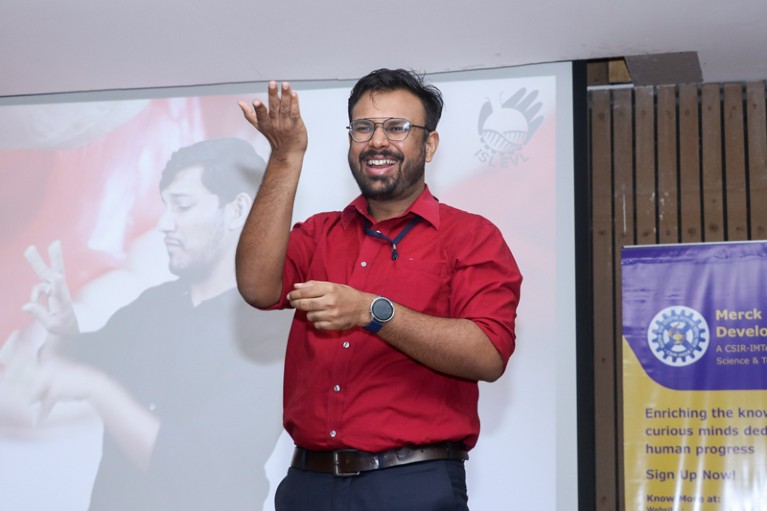
Digvijay Singh, a sign-language educator, says that there are not enough scientific terms in Indian Sign Language.
Credit: CSIR IMTECH
At the age of 11, my interest in science grew, but the lack of sign-language fluency among my teachers made learning science challenging for me. As a teenager I turned to the Internet to explore fascinating science topics, but I still struggled to understand them because of a lack of science, technology, engineering and maths (STEM) signs in Indian Sign Language (ISL).
In 2017, after studying English and social sciences at the Indira Gandhi National Open University in New Delhi, I became a teacher for deaf children at a primary school. And in 2018, I joined a branch of the
Haryana Welfare Society for Persons with Speech and Hearing Impairment
(HWSPSHI), an organization based in Panchkula, India, that trains teachers and runs education centres for deaf schoolchildren. There, I helped to teach ISL to deaf children up to the age of six, as well as to their parents and grandparents.
In 2022, I had an opportunity to work on the Indian Sign Language Enabled Virtual Laboratory (ISLEVL) project, which was set up by the Council of Scientific and Industrial Research’s
Institute of Microbial Technology
(CSIR IMTech). I joined a six-member team in the lab led by molecular biologist
Alka Rao
, and we started doing the exciting work of translating science-outreach videos and other content generated by the CSIR labs across the country into ISL. However, it turned out to be an extremely difficult task because of the lack of appropriate signs. But with the help of my teammates, we developed a strategy.

What’s the sign for ‘centrifuge’? How we added scientific terms to Indian Sign Language
First, I watch the videos that need to be translated and try to understand the content — with the help of an ISL interpreter. Next, I discuss the topic with Rao and the research fellows in the lab to clarify any scientific terms and concepts that I find difficult. For example, for the concept of an atom, the PhD students showed me an image of a nucleus surrounded by electrons on the computer.
Then, if I come across a term that is not in the ISL dictionary, I consult other sign languages, such as American Sign Language (ASL), to see if it has a sign. If I find one, I adapt it to ISL. But many ASL signs use fingerspelling that can take time to understand and that most deaf children in India will not be familiar with, because it differs from the signs used in ISL. So instead, on the basis of the concept, I develop a sign that depicts the shape of the object we are trying to describe and the function of the word.
For example, for the word bacteria, I created a sign that uses four fingers of one hand to represent the pili — hair-like structures on the surface of bacteria — and with the other hand,
I sign the movement of the tail-like flagellum
.
Sometimes, I create a completely new sign if one doesn’t exist in any other sign language. For example, I have come across the term ‘atmospheric water generation’ frequently in many of the CSIR videos — a concept that describes extracting drinkable water from humid air. But there was no ISL sign for it. So, I developed one. The vertical palm of the left hand represents a cooling condensation device. Then the outstretched palm of the right hand, facing away from the signer, is taken towards the left palm and closed.
This closed-hand shape then moves downwards with an extended index finger
, which represents small drops of water.
I discuss the new signs with Rao and members of the ISLEVL, including my deaf friends Hoshiyar Singh and Vivekanand Jaiswal (who are not scientists but are fluent in ISL) and with two hearing ISL interpreters, Theresa Arulavti and Sakshi Sharma. I also test the signs out on Navjot Singh, a hearing project assistant in the lab, who is not fluent in ISL. Then, in video calls I discuss the signs with ISL specialists to get their input.

Collection: Disability and ableism in science careers
If necessary, I modify the sign, and finally we make a vocabulary video in the format set by the national Indian Sign Language Research and Training Center based in New Delhi. We then submit it to them for final validation and then the sign gets added into the national ISL dictionary.
We also conduct workshops in schools and at IMTech. In June last year, Hoshiyar Singh and I ran a workshop for teachers at schools run by HWSPSHI on developing STEM literacy and concepts using ISL. It included lectures and demonstration sessions to explain the resources that our lab group has made, which can be used alongside their usual teaching methods. The teachers were so excited to have STEM signs that they can use in their classrooms. Furthermore, we received videos from deaf students through WhatsApp, highlighting their eagerness to explore scientific topics such as astronomy. Although these messages made me happy, they also fill me with a deep sense of responsibility.
Deaf people like me need their own language for communication and learning, but Indian Sign Language is still in the development phase, having only just emerged as a standardized language in the late 1990s. We truly do not have enough STEM signs in ISL. This project is the first serious attempt in the country to fill this gap. It will give deaf people an exposure to the scientific world and confidence that any deaf person can start learning STEM subjects and improve their lives.
This interview has been edited for length and clarity.
